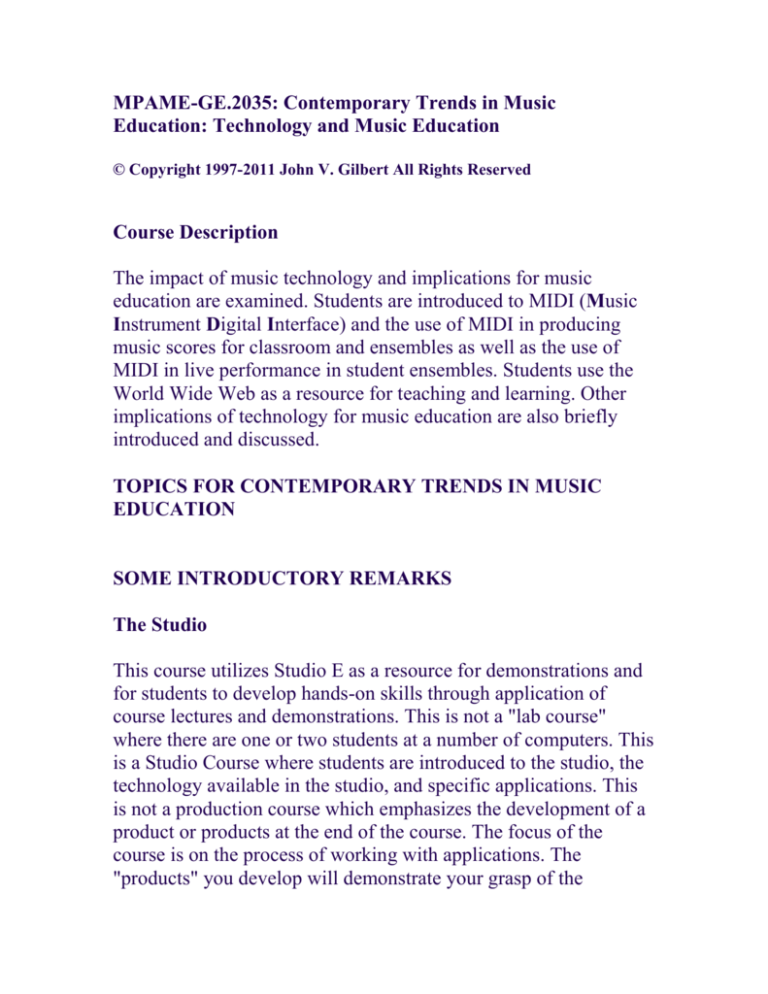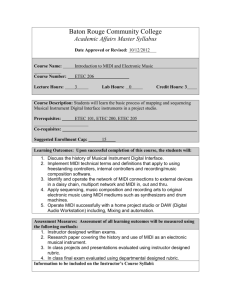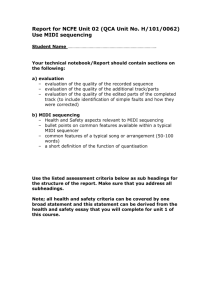
MPAME-GE.2035: Contemporary Trends in Music
Education: Technology and Music Education
© Copyright 1997-2011 John V. Gilbert All Rights Reserved
Course Description
The impact of music technology and implications for music
education are examined. Students are introduced to MIDI (Music
Instrument Digital Interface) and the use of MIDI in producing
music scores for classroom and ensembles as well as the use of
MIDI in live performance in student ensembles. Students use the
World Wide Web as a resource for teaching and learning. Other
implications of technology for music education are also briefly
introduced and discussed.
TOPICS FOR CONTEMPORARY TRENDS IN MUSIC
EDUCATION
SOME INTRODUCTORY REMARKS
The Studio
This course utilizes Studio E as a resource for demonstrations and
for students to develop hands-on skills through application of
course lectures and demonstrations. This is not a "lab course"
where there are one or two students at a number of computers. This
is a Studio Course where students are introduced to the studio, the
technology available in the studio, and specific applications. This
is not a production course which emphasizes the development of a
product or products at the end of the course. The focus of the
course is on the process of working with applications. The
"products" you develop will demonstrate your grasp of the
processes involved. The course is also focused on how technology
can extend the potential of our efforts as professionals in music
and especially as music educators.
TECHNOLOGY IN THE SERVICE OF MUSIC
EDUCATION: AN INTRODUCTION
The Marriage of Music and Technology
The relationship of music to technology is not new. If we regard
technology as the extension of human ability through technical and
process-oriented applications we realize that the moment human
beings began to move to technology for music making the moment
they used other means beside the human voice to make music.
Much of the history of music and musical styles can be looked at
as the development of technology to serve music. Machines for
making music such as keyboards, violins, wind and brass
instruments, percussion instruments, etc. have been steadily
modified throughout history in order to increase the range of
human capacity for making music.
Recent developments in digital technology have impacted on all
phases of music making, from digitized sound sources, sampling of
acoustic sounds, digital recording, to creation of sound scores and
music notation. This technological leap has transformed not only
how people make music, but also how music is delivered to a
public and how people listen to music.
In addition to impacting directly on music making, the new
technologies have direct bearing on how we teach music.
Developments of the internet and World Wide Web and other
means of communicating information such as CDRom, now
provide a tremendous resource for miusic educators at all levels.
*
Technology as the extension of human activity
*
*
*
*
*
*
*
*
*
*
*
*
*
Instruments as machines
Recording (Analog & Digital)
Computers
MIDI
Notation Software
Sequencing Software
Sound Editors
Synthesizers
Courseware
Record Keeping
Internet
Establishing Your Internet Account
Using E-mail As An Enhancement To The Class Activities
TEACHERS AS COMPOSERS AND ARRANGERS
*
Using Models To Get Started
*
Simple Forms
*
Composing For A Purpose
*
Arranging As Composing
SOUND, SYNTHESIS, AND SYNTHESIZERS
*
*
*
*
*
*
*
*
*
*
*
Fundamentals of Sound
Synthesizing Sound
Principles of Synthesis
FM Synthesis
Additive Synthesis
Phase Distortion
Analog vs Digital
Sources, Controls, Treatments
Waveforms
Filters
Modulation
*
Reverb
*
Delay
*
Sampling
*
Integrated Keyboard and Sound Modules
*
Sound Modules (Rack mounted, etc.)
*
Keyboard Controllers
PERIPHERALS
*
*
*
*
*
*
*
*
*
Amplifiers
Speakers
Cables, Wires, Connectors, Adapter s
Mixers
Signal Path
Treatments (Aux)
Line Signals
Microphone Connections
The Ins and Outs of Getting Connected
DIGITAL AUDIO
*
Digital Recording
MIDI
*
*
*
*
*
*
*
*
*
*
Tutorial on MIDI and Music Synthesis
Music Instrument Digital Interface
Basic concepts of control
Visualizing MIDI relationships
MIDI IN
MIDI OUT
MIDI THRU
MIDI Interfaces
MIDI Without Computers
Computers and MIDI
*
MIDI Menu of Websites
DESKTOP MUSIC PUBLISHING
*
*
*
*
*
*
*
*
*
*
*
*
*
*
*
*
*
*
*
Notation Software
Finale
Finale Files
Finale Users
Nightingale
Notescan
Overture
Principles of Computer Notation
Score Preparation and Layout
Inputting music
Using MIDI as a reference for sound
Assigning instruments to scores
Compositional aids
"Exploding" piano scores into arrangements
Save, Save, Save your work (Making backups)
Printing Scores
Extracting, Printing Parts
Copyright Issues
SEQUENCERS
*
*
*
*
*
*
*
*
*
Introduction to Sequencing Software
Vision
Mark of the Unicorn
Notator Logic
Cake Walk
FreeStyle
Integrated Sequencing and Digital Recording
Basic Principles Of Sequencing Software
Composing in Real Time
*
*
*
*
*
*
Capturing Sequences
Editing Sequences
Assigning Instruments and Tracks
Instrumental Librarians
Modifying and Saving Voices
Editing Sound
TERM PROJECT
All students will develop a website that will serve as their personal
learning "scrapbook" or journal. The website should be continually
updated with information and insights related to the course.
In addition, students will select one activity from the options
below:
1. Using Nightingale, compose or arrange a piece for chorus and at
least three instruments or for an instrumental ensemble such as you
might direct in a school setting. Provide a master score and extract
the parts. Preface your work with a discussion of the process you
used and the educational context of your work.
OR
2. Using the sequencer Freestyle, write or arrange a piece of music
which explores the sound possibilities of synthesizers.
OR
3. Utilize digital audio in the creation of a multimedia piece using
the synthesizer along with recorded environmental or acoustic
sounds.
OR
4. Develop a research paper which illustrates the use of MIDI for
music education in which you provide hypertext examples of
music synthesis and music notation. This will be written in html
(hypertext) and posted on the WWW at your NYU website.
Your plan for the project as well as documentation for the project
will be posted on the WWW at your NYU website. All projects
should include discussion of the relevance of the project to
concepts in music education.
EVALUATION
You will be evaluated on attendance, class participation in
questions and discussions, initiative, presentation (including e-mail
questions and replies, and especially your website), requested
written assignments, examination, and term project. All
assignments should be in your folder on the computer. Eventually
they will be forwarded to the instructor as attachments to e-mail,
with some exceptions. Be sure to make a backup of your work on a
floppy disk or a ZIP disk. Excuses that the work was completed
but accidentally erased from the hard drive are not acceptable.
Making backups is part of your weekly routine in the Studio.
This is a graduate course and each student is expected to go
beyond the minimum requirements of the course and the specific
assignments. Assignments serve as starting points. Students are
expected to challenge themselves at their level. The background of
each student with regard to music technology is taken into account
in the evaluative process. In general, the evaluation will use the
following guidelines for determining the final grade:
*
50% Assignments in folder and on website
*
30% Final Project
*
10% Internet Exams
*
10% all other (attendance, email, participation)
The above serve only as guidelines. Extraordinary work and
evidence of initiative and imagination will be rewarded.
POLICY ON INCOMPLETES
Incompletes are not available for Studio courses because studio
time expires at the end of the term.
Textbook (optional):
Huber, David Miles. The MIDI Manual. SAMS, Carmel, Indiana.
1991.
ASSIGNED WEBSITES & READINGS
Journals:
Music Educators Journal. MENC. Monthly
*
MENC
Computer Music Journal. Cambridge MA: The MIT Press, 1976- .
Quarterly.
Electronic Musician. Emeryville CA: NBB Acquisitions, 1984- .
Monthly.
*
Electronic Musician on the Web
Keyboard. Cupertino CA: GPI Corp., 1974- . Monthly
*
Keyboard Central
REFERENCES
Anderton, Craig. MIDI for Musicians. Amsco Publications, NY.
1986.
Boom, Michael. Music Through MIDI. Mincrosoft Press,
Redmond, WA. 1987.
Davies, Rick. "Musical Multitasking." Electronic Musician, (April,
1990): 43-52.
De Furia, Steve, and Joe Scacciaferro. MIDI Programmer's
Handbook. Redwood City, CA. M & T Publishing, Inc. 1989.
Grandmont, John. "High Tech in the Music Classroom." Recorder,
(May, 1991): 91-98
Hall, W. Vann. "Conquering The MIDI Muddle." Music Educators
Journal, (December, 1986): 26 ff.
Rubin, David M. Desktop Musician. Osborne, NY. 1992.
Mueth, Larry. "The MIDI Exchange." Music Educators
Journal/Teaching Music, (August, 1993): 38 ff.
Muro, Don. "An Overview of Electronic Musical Instruments."
Merrick, NY: J.D. Wall Publishing Co. and Korg Corp., 1988.
Videotape, 0:30, VHS.
Muro, Don. The Art of Sequencing: A Step by Step Approach.
Warner Brothers. 1990.
Rudolph, Thomas E. Teaching Music With Technology. GIA
Publications, Inc. Chicago, IL. 1996.
Wood, Robert W. "MIDI in the Music Curriculum: Preliminary
Considerations." Recorder, (August 1992): 117-121.
The MIDI Companion
Mind Over MIDI
------------------------------------------------------------------------
Copyright by Prof. John V. Gilbert
Send feedback or questions to gilbert@is2.nyu.edu
Textbook:
(optional) Huber, David Miles. The MIDI Manual. SAMS, Carmel,
Indiana. 1991.
ASSIGNED WEBSITES & READINGS
Journals:
Music Educators Journal. MENC. Monthly
*
MENC
Computer Music Journal. Cambridge MA: The MIT Press, 1976- .
Quarterly.
Electronic Musician. Emeryville CA: NBB Acquisitions, 1984- .
Monthly.
*
Electronic Musician on the Web
Keyboard. Cupertino CA: GPI Corp., 1974- . Monthly
*
Keyboard Central
REFERENCES
Anderton, Craig. MIDI for Musicians. Amsco Publications, NY.
1986.
Boom, Michael. Music Through MIDI. Mincrosoft Press,
Redmond, WA. 1987.
Davies, Rick. "Musical Multitasking." Electronic Musician, (April,
1990): 43-52.
De Furia, Steve, and Joe Scacciaferro. MIDI Programmer's
Handbook. Redwood City, CA. M & T Publishing, Inc. 1989.
Grandmont, John. "High Tech in the Music Classroom." Recorder,
(May, 1991): 91-98
Hall, W. Vann. "Conquering The MIDI Muddle." Music Educators
Journal, (December, 1986): 26 ff.
Rubin, David M. Desktop Musician. Osborne, NY. 1992.
Mueth, Larry. "The MIDI Exchange." Music Educators
Journal/Teaching Music, (August, 1993): 38 ff.
Muro, Don. "An Overview of Electronic Musical Instruments."
Merrick, NY: J.D. Wall Publishing Co. and Korg Corp., 1988.
Videotape, 0:30, VHS.
Muro, Don. The Art of Sequencing: A Step by Step Approach.
Warner Brothers. 1990.
Rudolph, Thomas E. Teaching Music With Technology. GIA
Publications, Inc. Chicago, IL. 1996.
Wood, Robert W. "MIDI in the Music Curriculum: Preliminary
Considerations." Recorder, (August 1992): 117-121.
The MIDI Companion
Mind Over MIDI









